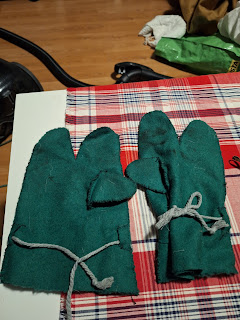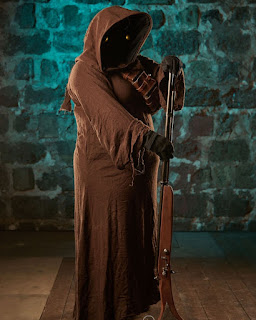With some time at home and some scrap wool I decided that I would do a pair of medieval mittens, since that would also help me complete one of the HSM challenges.
A lot of image sources for medieval mittens can be found here and Margaret Roe Designs also has a write-up and pattern for medieval mittens. Me being me I also decided that just a simple mitten would be too boring and easy, so I decided to make a three-fingered set of mittens. Also since I know from my modern winterwear that I really like the three-fingered design a lot, more nimble than a simple mitten but still warmer than gloves with individual fingers.
I started out with simply drawing an outline of my hand on white scrap fabric. (it's the table cloths from my wedding that I've kept as scrap fabric for making patterns and muslins.)
I have extremely short fingers, after all I forced my violin teacher to teach me differently since my reach was so much smaller than most people. At this time I also thought that I was going to make the mittens for my husband so I added quite a lot of extra length.
I made a thumb piece and a slit in the palm to add it. As you can see this first version of the thumb didn't work. It was so narrow that I could hardly get my thumb into it, and you have the big wrinkle going from the split of the two fingers and towards the thumb, there was obviously a lot strain there.
The new version of the thumb was a lot wider, and I moved the slit in towards more of the palm of the hand. With this version I was ready to cut out the proper fabric. The fabric that I used is a very green wool, I think the colour is too bright to really feel historical and it is kind of a stiff fabric, so I treat it as my "worst" wool fabric, but good for this kind of small experimental projects.
Each mitten consists of four pieces, a front and back main piece and two thumbpieces. The thumb was made more narrow from the pattern. All pieces were joined together with whip stitches, and I started with the thumb before sewing the main pieces together.
Along the way I kept adjusting the size, so I kept taking the fingers in and make them shorter.
Here are the scrap that I cut off from the mittens while working on them.
I added two fabric loops on each mitten so that I could pull a string through to tighten the gloves. I had made them fairly wide so that I could pull them outside of my cuffs on my clothes, but I wanted them to be tight around the wrist so that they fall off too easily.
And this is me wearing the mittens, while holding a cup of hot, spiced beer
What the item is: A pair of medieval mittens
How it fits the challenge: it is a pair of mittens
Material: Wool fabric
Pattern: My own
Year: Late Middle Ages
Notions: thread, cotton string
How historically accurate is it? Accurate pattern, but the material is decent but not totally accurate so somewhere around 50%
Hours to complete: 4 hours ( I am a slow handsewer)
First worn: At a Christmas market on December 10th
Total cost: All made from stash, but bought new around $10.



















































